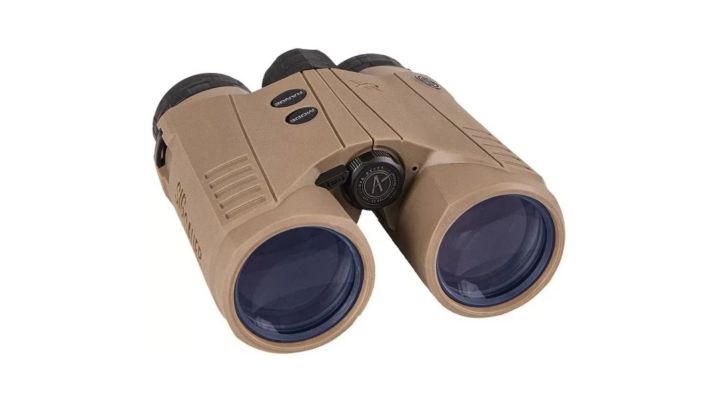We may earn revenue from the products available on this page and participate in affiliate programs.

Rangefinder binoculars might seem like an odd combination — like a fork and spoon creating a spork — but they fill a niche role that gives hunters multiple advantages. There is, of course, the titular function (range finding, duh), but many also include calculators to do ballistic math for you and provide higher magnification than their monocular counterparts. Plus, using both eyes means you’ll get a higher field of view, making it easier to see your target.
If you want improved visibility and excellent range estimations at long distance, continue below to find a list of the best rangefinder binoculars on the market.
- Best Overall: Leica Geovid Pro 10×32
- Best for Hunting: Vortex Fury HD 5000 AB
- Best for Long-Range Shooting: Sig Sauer Kilo10K-ABS HD
- Best Budget: Bushnell Fusion X 10×42
- Honorable Mention: ATN Binox 4k 4-16X
Best Overall
Leica Geovid Pro 10×32
Best for Hunting
Vortex Fury HD 5000 AB
Best for Long-Range Shooting
Sig Sauer Kilo10K-ABS HD
Best Budget
Bushnell Fusion X 10×42
Honorable Mention
ATN Binox 4k 4-16X
Things to consider before buying rangefinding binoculars
Benefits of rangefinding binoculars
Well, first off, what are you doing? If you’re just hiking through the woods and birdwatching, I’m not even sure why you’ve made it this far on this list. But if you’re into shooting, then maybe these are for you. Rangefinding binoculars are better than their monocular counterparts because you’re looking through lenses through both eyes, allowing for a wider FOV. Additionally, binoculars tend to have higher magnification.
For example, the Vortex Fury featured here has a 10x magnification and an FOV of 321 feet. By comparison, Vortex’s Razor HD 4000, its top-end monocular rangefinder, has 7x magnification and an FOV of 341 feet. The extra magnification at the cost of some view (and increased price) might be worth it to some shooters.
Features
Besides the titular feature of these binos, there are usually a few other goodies involved.
Horizontal distance calculator
The most common is the horizontal distance calculator. The rangefinder finds the angle from level ground to target, and then multiplies the range found by the cosine of the angle. One quick calculation later, it spits out the horizontal distance. The reason for this is because, regardless of the angle fired, gravity pulls the bullet down at the same rate. For example, a shot taken at a 35-degree angle at 450 yards has a horizontal component of roughly 370 yards, and the bullet will drop the same amount that it would from a 370-yard shot. So if you don’t have a ballistics calculator or your phone is dead and you can’t access the app of your choice, you can refer to your dope card or range book or what-have-you, and still make an accurate shot.
Ballistics calculators
Speaking of ballistics calculators, maybe you’ve chosen a rangefinder with one onboard. Basically, it will take the information that I’ve detailed above, punch that range in (or Bluetooth will do it for you), and add in other data like wind, barometric pressure, known rifle performance, etc. It does all the work for you, and tells you how far to adjust your shot.
Scan
Another popular feature is a scan mode. This keeps the rangefinder actively on as you visually scan your surroundings. Typically, you can also set the rangefinder to record the ranges that measure closest or furthest to positively ID a target, like a deer in a field.
FAQs about rangefinder binoculars
Q: Does Leupold make rangefinder binoculars?
A: Not anymore. For a short time, Leupold offered a rangefinding binocular called the RBX-3000. However, it seems that it was discontinued by Spring 2020.
Q: Do rangefinders have magnification?
A: Almost all do. The added magnification allows users to more accurately aim at targets, thus getting a range calculation. That said, I’ve noticed that the binocular rangefinders tend to have stronger magnification than their monocular counterparts.
Q: What rangefinder does the military use?
A: Recently, the Army and Marines issued contracts for weapon-mounted rangefinders. L3Harris won the contract for the Small Tactical Optical Rifle-Mounted Micro Laser Rangefinder 2 (STORM 2) for the Army, while Optic 1 was awarded the contract for the Integrated Compact Ultralight Gun-mounted Rangefinder (I-CUGR) for the Marines. Unfortunately for you LARPers out there, these don’t seem to be available for the general public.
Final thoughts
If you’re still not sure which set of binos is for you, let’s break it down simply. If you want the best option out there, featuring premium glass clarity and excellent rangefinding capabilities with all the high-tech bells and whistles, select the Leica Geovid Pro. If you’re wanting the best for long-range hunting and shooting, then either the Razor Fury or Sig Sauer Kilo will serve you well. Meanwhile, if you’re balling on a budget, look no further than the Bushnell Fusion X. And if you want to measure range at night and make the most of digital zoom, select the ATN Binox. All are excellent options in their own right. But if you’re still not convinced of binoculars, maybe check out this list of monoculars, where we tested out the best rangefinders on the market.
Methodology
For this buyer’s guide, I was looking for information regarding performance data. A rangefinder that sucks at measuring range is just a paperweight. I was looking at effective range, field of view, and also checking for features such as ballistic calculators. End-user reviews were vital to this selection, as were individual reviews and forum discussions. In particular, data from the Long Range Hunting forum, as well as reviews from Outdoor Life and Petersen’s Hunting were extremely helpful.







